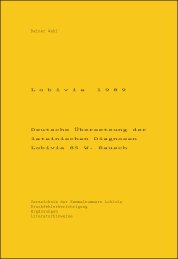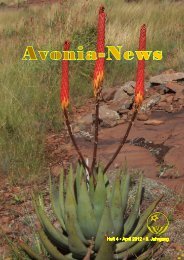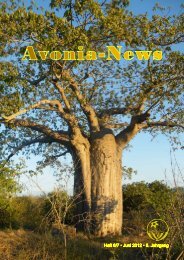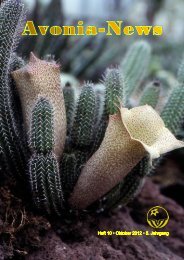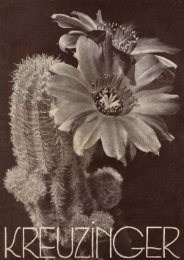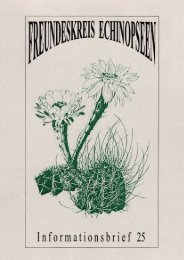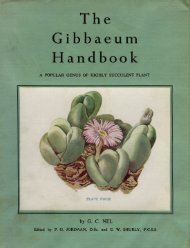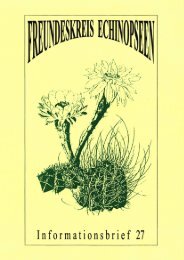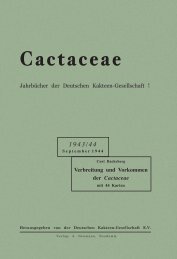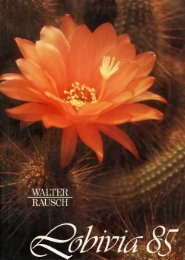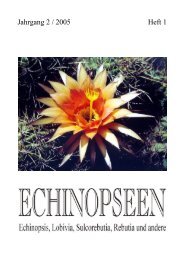VOLUME 14 :: January—October, 1952 Illustrations shown in ...
VOLUME 14 :: January—October, 1952 Illustrations shown in ...
VOLUME 14 :: January—October, 1952 Illustrations shown in ...
Create successful ePaper yourself
Turn your PDF publications into a flip-book with our unique Google optimized e-Paper software.
THE CACTUS AND SUCCULENT January, <strong>1952</strong><br />
THE SYSTEMATICS OF CONOPHYTUM N.E. Br.<br />
By Dr. A. TISCHER<br />
Translated by E. Engler<br />
When <strong>in</strong> the year 1922, N. E. Brown, by separation from Mesembryanthemum L, formed the genus Conophytum*,<br />
about fifty species, that were adjudged to this genus, were known. Already Brown himself felt the need to group<br />
these species accord<strong>in</strong>g to def<strong>in</strong>ite characteristics. In the meantime, the number of described species and forms<br />
has grown to nearly three hundred. The necessity for a systematic arrangement of this large number of species,<br />
has prompted a number of scientists to suggest a division <strong>in</strong>to groups and sub-groups. Such proposals emanated<br />
from N. E. Brown, L. Bolus, Herre and especially Schwantes**. The most comprehensive systematics, up to the<br />
present, was recently published by Schwantes <strong>in</strong> " Kakteen und andere Sukkelenten," year 1950, No. 5, and 1951,<br />
Nos. I and 2. The work represents a cont<strong>in</strong>uation of his earlier systematic studies, but deserves special notice for<br />
the reason that here, for the first time, attention is drawn to the limited geographical distribution of the members<br />
of each group. Accord<strong>in</strong>g to these writ<strong>in</strong>gs, conclusions <strong>in</strong> regard to the systematic aff<strong>in</strong>ity of a species can already<br />
be drawn from the place of occurrence. At all events, for future f<strong>in</strong>ds, the systematic group<strong>in</strong>g will thereby be<br />
considerably facilitated. It is regrettable, though, that Schwantes had only limited plant and flower material at<br />
his disposal. Thus, a number of species could not be taken <strong>in</strong>to consideration <strong>in</strong> the group<strong>in</strong>g, others were grouped<br />
wrongly, due to <strong>in</strong>sufficient knowledge of the flower. Nevertheless, all further systematics of Conophytum will<br />
have to build on the f<strong>in</strong>d<strong>in</strong>gs of Schwantes.<br />
Accord<strong>in</strong>g to the fundamental rules of modern Botany, for the group<strong>in</strong>g of species, it is, <strong>in</strong> the first place, the<br />
sex characteristics which count. In future systematic exam<strong>in</strong>ations of Conophytum, we shall have to pay attention<br />
to these pr<strong>in</strong>ciples even more than <strong>in</strong> the past. In this task the exam<strong>in</strong>ation of seed, ovules, or even of the chromosomes<br />
will perhaps br<strong>in</strong>g us knowledge of aff<strong>in</strong>ities which we were not able to have up to now. First of all, we<br />
shall have to concentrate chiefly on the characteristics of the flowers. I myself had the opportunity, dur<strong>in</strong>g the<br />
past years, to study not only an extensive plant material of this genus, but also to observe the flowers of a large<br />
number of species. I was assisted <strong>in</strong> my work by means of h<strong>in</strong>ts, plants and literary material, particularly by<br />
Messrs. Bates, of Hounslow, Capta<strong>in</strong> Dunne Cooke, of London, Dr. de Boer, of Haren, Herre, of Stellenbosch,<br />
Jacobsen, of Kiel, Professor Schwantes, also of Keil, Graessner, of Perleberg and Triebner, of W<strong>in</strong>dhoek, to whom<br />
I would extend my special thanks here.<br />
My studies enable me partly to supplement the systematic f<strong>in</strong>d<strong>in</strong>gs of Schwantes, partly to amplify them, so<br />
that I can now submit suggestions for a systematic group<strong>in</strong>g of all species known to me as hav<strong>in</strong>g been described.<br />
The body shapes of the Conophyta allow them to be traced back to a number of fundamental types. Already<br />
<strong>in</strong> 1922, N. E. Brown set up a table of types, which comprised types of body shapes***. The large number of species<br />
and forms, which have become known meanwhile, make a still more thorough characterisation of the fundamental<br />
types desirable. I have, therefore, enlarged the number of types set up by Brown and established a new type table.<br />
In the follow<strong>in</strong>g systematics of the genus Conophytum the types belong<strong>in</strong>g to the groups have been mentioned<br />
<strong>in</strong>dividually.<br />
The systematics given <strong>in</strong> this work does not replace a key to the species of Conophytum. But, <strong>in</strong> order to<br />
facilitate the ascerta<strong>in</strong>ment of species for the benefit of those who are <strong>in</strong>terested scientifically, or of friends of these<br />
attractive plants, I have added to each species, <strong>in</strong> parenthesis, the colour of the flower and the type of the type table.<br />
In this connection, w means white, c—cream or ivory, y—yellow, o—orange, co—coppery or salmon coloured,<br />
r—red, rs—rose red or rosy, p—purple or magenta, v—w<strong>in</strong>e coloured. For <strong>in</strong>stance (y/10) means " flower yellow,<br />
type 10 ; (r36/39) means flower red, type about 36 and 39. The figure <strong>in</strong>dicates only the contour of the little<br />
bodies, seen laterally, but does not signify the size of the bodies, which may be larger or smaller.<br />
CONOPHYTUM N.E. Br.<br />
Sub-genus ; Fenestrate N.E. Br.<br />
Plants with short stems, or stemless, form<strong>in</strong>g cushions. The small bodies — cyl<strong>in</strong>drical to obconical, flat to<br />
convex above, partly ± bilobate due to small fissure on the upper surface, lobes flat or slightly convex, not keeled,<br />
* The Gardener's Chronicle 1922, p. 198 and 450.<br />
** N. E. Brown I.e., Schwantes <strong>in</strong> Gartenflora 1927, page 424, L. Bolus <strong>in</strong> Notes on Mesemb., Part III, H. Herre<br />
<strong>in</strong> the Cact. and Succ. Journal of Gt. Brita<strong>in</strong>, Vol. 10, page 56 et seq., N. E. Br. <strong>in</strong> the Journal of the Cactus and<br />
Succulent Society of America, Vol. II, page 425.<br />
*** The Gardener's Chronicle, Vol. LXXI, pages 2<strong>14</strong> and 450.



